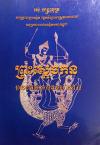
Ros Chantrabot រស់ ចន្រ្តាបុត្រ
Phnom Penh: Angkor Bookstore Press, 2007
Reviewed by Theara Thun (PhD Candidate, HYI-NUS Joint Doctoral Scholar)
Those familiar with Cambodian history probably have heard the story of a commoner named Kân, who became King after successfully mobilizing his supporters and defeating the previous king in a series of wars in the early 16th century. Born into a family belonging to the temple-servant class, Kân is regarded as one of the rare figures who successfully liberated his group from the extant social class structure and declared himself the 39th monarch of Cambodia (p. 3-4). However, after staying on the throne for about ten years, Preah Sdach Kân (literally meaning God-King Kân) was defeated in a series of long and destructive wars by a brother of the former king. As he was defeated and the old-blood-connected monarch was restored, Kân later became a figure portrayed in Cambodian royal chronicles and other literary texts as a ‘villain.’
French-educated Ros Chantrabot makes the ambitious attempt to challenge and push beyond the existing historical narratives surrounding Preah Sdach Kân. In the book’s preface, Cambodian Prime Minister Hun Sen highlights the author’s accomplishments in uncovering the unusual competencies and intelligence of Kân. According to the Prime Minister, this man, who was born in the year of the dragon and used to serve in a Buddhist temple, just like Hun Sen himself, should be regarded as a great world hero who promoted and implemented, for the first time, the concepts of ‘freedom rights’ and ‘class struggle’ among the public in the 16th century (p. ii-iii). The Prime Minister calls Kân’s activities in mobilizing his supporters and overthrowing the king the ‘first democratic people’s revolution’ in Cambodian history (p. iii).
In subsequent pages, Ros assembles different sources derived from Cambodian royal chronicles, French colonial scholarship, and his own field research in the area where Preah Sdach Kân built his capital. In the first two sections, which occupy the bulk of the book, the author narrates in detail Kân’s conflicts before and after taking over the throne. This information is mostly based on two major Cambodian royal chronicles,[1] written between the late 1920s and early 1940s. Except for emphasizing the greatness of this man, Ros closely follows these two sources to narrate the history of Cambodia during the first half of the 16th century. He takes the two texts very literally, paying little attention to the nature of these sources, which occasionally consist of fictitious and fabricated information (p. 12, 59, 98, 107, 115, 122). One must question how chronicles that were written over 400 years after the events took place could possibly be historically accurate, especially regarding the detailed information that the author uses for his illustration of Cambodian history. To be sure, the two chronicles were constructed based on older texts, including the oldest-known chronicle written in 1713/14.[2] But the two chronicles that Ros relies on present information about Preah Sdach Kân in much more elaborate detail than what is contained in any of those old texts. Most likely, the two royal chronicles reflect the perspectives of people behind the constructions of the texts, rather than offering accurate historical information about Kân.
Arguably, the last section of the book contains the most significant contribution of Ros’s project. The author locates the capital of Preah Sdach Kân, which French colonial scholar Adhémar Leclére had misplaced. Thanks to Ros’s research on the ground, the author is able to capture the geographical, historical, and cultural significance of the area located in the eastern part of today’s Cambodia.
[1] One of these royal chronicles is well known as the Samdach Vāmn Juon Chronicle. The microfilm copy of this hand-written text is available at Toyo Bunko library in Tokyo and Harvard-Yenching library at Harvard University.
[2] Mak Phoeun, “Cbāb Preah Rajapangsāvatā Kampuchea (Chronicle Texts of Cambodia).” in Khim Hoc Dy (ed.), Samohakam Aksarasāstra Khmer Utisjon Sāstrachār Keng Vannsak (Mixed Khmer Literatures in Honor of Professor Keng Vannasak). Phnom Penh: Angkor Bookstore Press, 2006. p. 60
